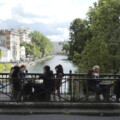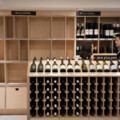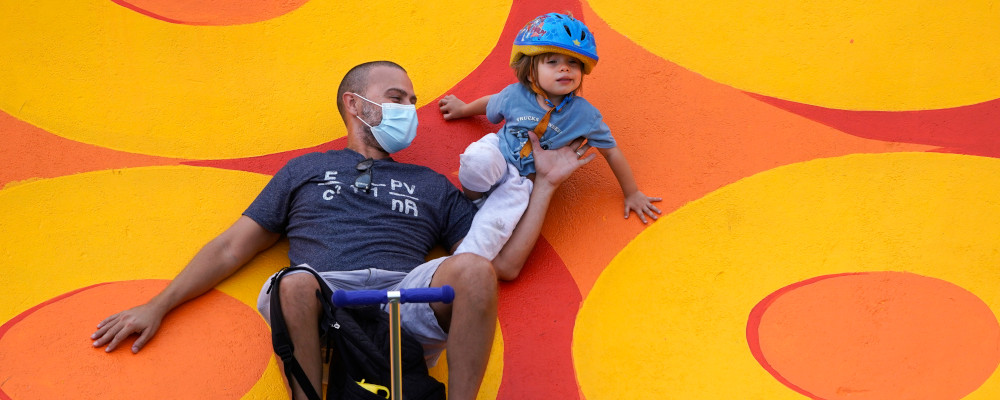An infallible way of reminding me that my ten-year-old son is growing quickly is feeling how much larger his hand feels in mine when we walk together. I guess I’ll know he’s fully grown when he won’t let me hold his hand anymore, but that thought is scarier than the rising water level threatening to submerge Miami, so we’ll push that aside. Émile and I have been walking the Miami Beach boardwalk hand in hand during every visit to the city since our first trip when he was 22 months old, and it’s been a highlight of our trips for seven years. We started with a stroller, which he would push ahead, misleading people who would cross our path to believe that this was a self-driving stroller (Tesla, are you paying attention?) since they couldn’t see little Émile behind the stroller, navigating the boardwalk without seeing ahead. When he got tired I would sit him in, recline the seat, and walk until he fell asleep. Back then his hand was so tiny, he would just hold one of my fingers to hang on.
Then he moved on to a three-wheel scooter which he would ride at worryingly high-speed, weaving between bikers, dogs, and elderly walkers. The boardwalk would lead us to what we considered hidden gems: parks and playgrounds sprinkled along the length of the path, always covered by trees to enjoy the cool shade. Now that he’s a preteen, the boardwalk often serves as a means to reach our destination and less as the entertainment itself, but we enjoy it wholly regardless.
When we think of Miami Beach we tend to picture three demographics: retirees, young partiers, and the obnoxiously rich and tacky. But Miami has much to offer to children of all ages, and their parents, in addition to its beaches and pools.

I knew I really hit the right note when Émile was spray painting graffiti inside of the Wynwood Walls. Miami’s original street art outdoor museum is globally celebrated and houses murals painted by world-renowned artists. Émile recognized the art of Shepard Fairy and Banksy and we discovered Hebru Brantley and Buff Monster together. We regaled ourselves on the sights of the brightly coloured wall art and admired the different techniques and styles. The ingenuity of Bordalo sculptures grabbed our attention and had us conduct a thorough examination of their elements and materials.
We recognized many components of “Plastic Mom n Baby Monkeys”, giant monkeys made out of discarded toys and other plastic materials. The ubiquitous Fisheprice xylophone forms the baby monkey’s teeth, and a tricycle handle, its nose. The playfulness of the art at Wynwood makes it accessible and interesting to children and by extension, their parents, because it’s effortless to walk through the museum when children are captivated. This being an outdoor museum, the weather needs to be finely calibrated to “not too hot and humid, and not raining either”.
When we walked through last week, the temperature was 32°C and we were getting sluggish. Some genius entrepreneur figured out that putting a popsicle cart smack in the middle of the museum path was a money-making machine, and we cooled down for a few minutes while savouring absolutely delicious real fruit sorbet bars made with mango and passion fruit. The entire visit, Émile had been asking me if he, too, could paint walls around the city, so it was a joyous surprise when we came across the “Official Street Art Experience”. We enjoyed a few minutes of graffitiing and leaving our marks on the murals, but you can also book a private lesson with a local artist, to learn real can control techniques and the key differences between slaps, paste-ups, stencil, wild style, blockbuster, throw-ups, tags, etc. This will definitely be on the books for our next visit.
While the popsicles were divine, they did not satisfy our increasing hunger and only one thing would: tacos. Wynwood appears to be THE city’s neighbourhood for genuine Mexican fare and our careful research led us to The Taco Stand, a small and unassuming taqueria offering an authentic taco experience. I enjoyed my grilled fish taco for its perfect combination of flavours and textures, and while Émile had high hope for his Angus beef tacos, he was a bit disappointed by the toughness of the meat. I thought it was delicious, but few palates are as discerning as a 10-yr old boy’s. The Taco Stand redeemed itself in his eyes with its warm churros, delivering on the crunchy exterior and fluffy doughy inside. At 2 pm we were DONE and made our way back to the beach for some much-deserved reading time by the sea and cooling down with regular swims.
The next day we made our way across Biscayne Bay to the Phillip and Patricia Frost Museum of Science. Located on Downtown Miami’s waterfront, the 250,000-square-foot museum is divided into four buildings: the Frost Planetarium, Aquarium, and North and West Wings. The buildings themselves are works of art, stunning structures connected by passageways and stairs under the Florida sun. All exhibits are highly interactive and meant to appeal to children of all ages.
From the aquarium to the dinosaurs to health sciences, it’s almost certain that any child would find an exhibit, or five in the case of Émile, that MUST be visited thoroughly and attentively. I particularly enjoyed the Planetarium, where we watched the twenty-five minutes ultra-high resolution full-dome production Dynamic Earth, narrated by actor Liam Neeson. The documentary explores the inner workings of Earth’s climate system and follows a trail of energy that flows from the Sun into the interlocking systems that shape our climate: the atmosphere, oceans, and the biosphere. I was puzzled when entire groups of Christian school children on a field trip got up and left 7 minutes before the end, but it all came together when the documentary described climate change as man-made and the consequences of rising water levels across the world. I guess science only goes so far for some Americans. After all, how would you explain to children that God would destroy the land that he made for humans to enjoy? I guess they also skipped the part of the exhibit on evolution and Darwin’s theory.
Four hours into our visit, the beach is singing its sweet mermaid call in my ears and I’m ready to leave. Before we head out, we decide to eat lunch at the Food@Science restaurant onsite. I’m positively surprised by their offerings, which include several appetizing salad bowls in addition to sandwiches and hamburgers. I order the vegan bowl with kale and butternut squash and Émile rolls his eyes at me while he orders the burger. I give my meal a solid eight out of 10 and Émile rates his hamburger an almost perfect score of 9.5. Then it’s back to the beach for endless games of catch and sand sculptures.
No visit to Miami is complete without sampling its wide array of delicious food and fine dining abounds in Miami. It’s usually easy to accommodate children’s tastes even in the finest restaurant here. Prices have been hiking up over the years but this visit felt especially onerous compared to previous trips. To offset the costs of dinners out, we tend to book hotels that have small studio kitchens available so that we can make our own breakfast and often lunches, and it also saves time since we don’t like to sit down in restaurants for hours when there is so much to explore.
Maybe the next time we walk on the Miami Beach boardwalk together, my son’s hands will be as large as mine, or maybe (gasp!) he won’t want to hold my hand anymore. But that’s okay, I’m sure he’ll always want to stroll with me down the sunny path, as long as there’s an ice cream cone at our destination.
Where to stay:
- For beachgoers: The Sagamore Hotel South Beach is a small boutique hotel with large suites appointed with well-stocked kitchens. The pool is surrounded by palm trees and comfortable lounge chairs and the crowd is less party animal and more family-oriented.
- For pool swimmers: The Mondrian South Beach is an upscale hotel on Biscayne Bay, therefore not on the beach. However, the pool is gorgeous and extravagantly large. When my son was three years old he spent all week sitting on the wide steps submerged in water up to his neck and talking to everyone around. All rooms have a small kitchen that met our eat-in needs. There is a Whole Foods a few minutes away to stock up on essentials.
Where to eat:
- The Dilido Beach Club at the Ritz-Cartlon has an inviting terrace with ocean views where adults can enjoy a delicious meal (try the Key West Cripsy Shrimp Tacos) and children can order off the kids’ menu a sensible meal that will appease their parents’ desire for nutritious dining. All meals are served with crudités and the offerings go beyond the usual kids’ fare, with Cobb Salad, Seared Salmon, and Chicken Penne amongst other options.
- Byblos has been a staple of our trips to Miami Beach. Eastern Mediterranean cuisine is served family style and everyone will find their favourites amongst the dozens of delicate dishes.
Recommended for You

Malcolm Jolley: The comfort of familiar favourites—or the fun of finding new wines?

Malcolm Jolley: An ‘Elbows Up’ wine project everyone can get behind

Malcolm Jolley: Need some summer wines? Look no further than the food-friendly, low-sugar sippers of the sunny Southern Rhône

Malcolm Jolley: Need a date-night drink? French Northern Rhône wines are worth the investment



